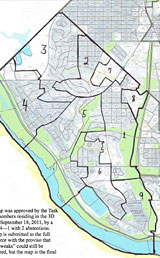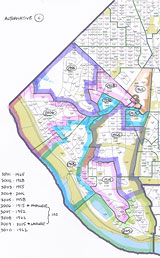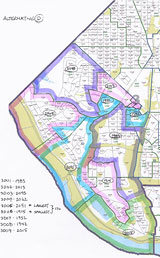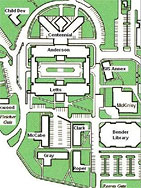ANC 3D redistricting gerrymanders students and residents
On Sunday night, a redistricting subcommittee for ANC 3D voted 4-3 to endorse a plan that illogically divides long-standing and well-defined neighborhoods. It blatantly under-represents and marginalizes the American University student population for solely political reasons.



Left: The approved Proposal #3, by Tom Smith and Jeffrey Kraskin.
Center and right: Alternatives C and D, by Kent Slowinski and Nan Wells.
Redistricting in ANC 3D, which covers neighborhoods from the Potomac River to Massachusetts Avenue, has been the subject of fierce debate over the past weeks. ANC 3D chair 3D02 commissioner Tom Smith and Ward 3 Redistricting Task Force Chair Jeffrey Kraskin were the principal architects of this proposal, dubbed Proposal #3. Meanwhile, 3D01 and 3D03 Commissioners Kent Slowinski and Nan Wells created two opposing proposals, Alternatives C and D.
Proposal #3, in its current state, would dramatically alter the current boundaries and violate many provisions in the DC redistricting codes and procedures. By further limiting student voice and participation in local DC politics, this plan continues the ongoing trend of illegally marginalizing and minimizing the representation and presence of college students across the District, especially at Georgetown University and American University.
This proposal lumps the American University campus population into essentially one 2,151 person district, the largest of the 9 SMDs in ANC 3D.
| SMD | Proposal #3 | Alternative C | Alternative D |
|---|---|---|---|
| 3D01 | 1,861 | 1,965 | 1,983 |
| 3D02 | 1,979 | 1,928 | 2,013 |
| 3D03 | 1,912 | 1,955 | 2,043 |
| 3D04 | 1,984 | 2,006 | 2,062 |
| 3D05 | 2,048 | 1,958 | 2,091 |
| 3D06 | 1,933 | 1,915 | 1,915 |
| 3D07 | 2,151 | 1,952 | 1,952 |
| 3D08 | 2,130 | 1,962 | 1,942 |
| 3D09 | 2,043 | 2,015 | 2,015 |
| 3D10 | 1,962 |
In doing so, students are completely removed from 3D02 (coincidentally represented by Commissioner Tom Smith), whose seat was closely contested by students in 2010. Intentionally redrawing almost the entire AU student body into one district limits student voting power and therefore collective influence to one of nine seats.
It is also specifically drawn to include projected increases in student housing, which means by the fall of 2014, ANC 3D07 would, by the current census and upon adoption of the currently proposed Campus Plan, hold, at minimum, 2,954 students. While we grant that these projected numbers are not based on Census 2010 data, this situation is important to note.
Alternatives C and D also maintain sensible neighborhood boundaries, and avoid the creatively disjointed districts delineated by their counterpart. Unlike Proposal #3, which cuts across major roads, buildings, and within communities to create politically constructed voting blocks, this proposal fairly distributes representation across appropriate areas without violating provisions that prohibit dilution of student and homeowner votes.
Several ANC members and their constituents have supported the Slowinski/Wells plans, and believe the plans are in the best interests of all residents. Alternative C adds a 10th SMD and incorporates some land currently part of ANC 3E, which has been the subject of contention. That being said, Alternative C stands not only as a sensible and pragmatic solution for 3D, but it also allows 3E redistricting numbers to be in compliance.
If the theoretical new district covering the Department of Homeland Security and a number of apartment buildings are not brought into 3D, the 3E maps will have to be re-configured. It further enhances the commonality of the neighborhood along MacArthur Blvd, greater Wesley Heights, and the Spring Valley/AU area.
Regardless, many have noted that the process over the past weeks has been less than transparent, open, and democratic. As the Smith/Kraskin plan (Proposal #3) has drawn opposition from the Slowinski/Wells proposals, many have alleged that the process is rife with conflicts of interest and political motivations. Ward 3D chair Tom Smith refused to allow the consideration of the process and of the various proposals at public ANC meetings. Circulation and discussion of proposed maps was very limited.
The first subgroup redistricting 3D group vote on Sunday night passed Proposal #3 over Alternative D by a 4-3 margin. The second vote was on Stu Ross’ motion to accept the Smith/Kraskin #3 map with an amendment, with a potential for “tweaks.” In a measure of protest, Commissioner Slowinski abstained from the vote, the final tally being 4-2-1. The last vote was 5-0 to object to a 10-member ANC, with Bill Slover (Palisades) and Kent Slowinski abstaining.
It is also important to note that only members of the Redistricting Task force are able to vote officially on any of the proposed plans. DC Council appointed members of the Task Force, and representatives such as Commissioner Wells and Jones, were unable to vote on these proposals. No AU students are members of the task force.
We see further problems with the current proposal as it stands. American University has a design capacity for just over 3500 students and is projecting to house approximately 4300 students by fall 2014. However, under Under §1-1332 of the DC Code:
(e) No redistricting plan or proposed amendment to a redistricting plan shall result in district populations with a deviation range greater than 10% or a relative deviation greater than plus-or-minus 5%, unless the deviation results from the limitations of census geography or from the promotion of a rational public policy, including, but not limited to, respect for the political geography of the District, the natural geography of the District, neighborhood cohesiveness, or the development of compact and contiguous districts.
Current Census numbers show that the Proposal #3 population total falls outside the 1900-2100 limits set by the Task Force committee. Alternatives C and D are in compliance.
While the numbers in the Smith/Kraskin plan already exceed the given population boundaries, projected growth under the new campus plan would clearly continue to violate this provision. While other Wards have constructed their SMD’s to anticipate projected growth in the area, the new lines under Proposal #3 clearly ignore projected changed for the purpose of consolidating AU voting influence into merely one seat. Such an action further disenfranchises the student vote, as section §1-1332 of the DC Code stipulates that:
(f) No redistricting plan or proposed amendment to a redistricting plan shall be considered if the plan or amendment has the purpose and effect of diluting the voting strength of minority citizens.
The definition of “minority citizens” is not specifically defined, yet it is fair to say that students constitute a minority in DC, and that the proposed plan deliberately attempts to confine their influence to one vote. It ensures that any student vote in the current 3D02 district will be removed, meaning that Commissioner Smith will be able to continue opposing students on many issues without fear of being voted out of office.
While it is mathematically impossible to cram the entire AU population into one district, Proposal #3 attempts to do so by consolidating every dorm on campus (except for Letts Hall) into one ANC seat.
The map at right shows what is referred to on campus as “Letts-Anderson Quad”. Letts, Anderson, and Centennial Halls, while all classified as separate dormitories, are actually one large connected complex (total estimated population: 1802 students).
There are no legal roads cutting through LA Quad and once a person enters the residential complex, he or she can go to any part of the three dorms without ever going outdoors. This arbitrary division disregards the mandate of redistricting task forces to maintain neighborhood continuity.
The disruption of neighborhood continuity does not end with the dissection and reforming of AU’s campus. 3D01, 02, 03, and 07 (all the districts comprising or bordering AU) will face significant changes. If Commissioner Smith’s plan passes, the Spring Valley and Wesley Heights neighborhoods will be fundamentally divided in a way that disregards natural boundaries and accepted community lines.
Proposal #3 has another major downside: it inevitably will negatively change the landscape of relationships between the AU administration, AU students, and neighboring community members. The existence of a SMD that is equally divided among students and neighboring residents increases the feasibility that students and neighbors can fairly work together.
By limiting student voting influence on the ANC to one seat, this proposal eliminates accountability on the part of other ANC members to student needs and concerns. It is important to remember that students and homeowners are more than capable of working together both inside and outside of the democratic process, should the political shenanigans be put aside.
Districts that include both students and neighbors are integral to maintaining and establishing cohesion between these citizen groups because any ANC commissioner elected in such a district should reasonably consider the needs of all constituents, allowing for a more moderate voice. This article need not be interpreted as another attempt to portray this discussion as a two-sided debate.
We understand the difficulty of this process and the opposing viewpoints in play, yet we stress the need for an equitable solution that fairly considers all residents and allows for the best solution. As students, we value and appreciate the surrounding area as a welcoming and respected community, and we encourage further collaboration and partnership among all.
Proposal #3 clearly gerrymanders and marginalizes a significant and vulnerable group in ANC 3D. The best solution is to adhere as closely as possible to the current boundaries of the ANCs in 3D. Therefore, we endorse Alternatives C and D authored by Commissioners Slowinski and Wells. This reasonable alternative begins with the only generally accepted standard, the existing boundaries from 2001-2011, and makes minor and reasonable adjustments to most fairly represent every citizen of ANC 3D.
A public hearing of the Ward 3 redistricting task force will take place tonight at 7 pm, at the Horace Mann Elementary School.

